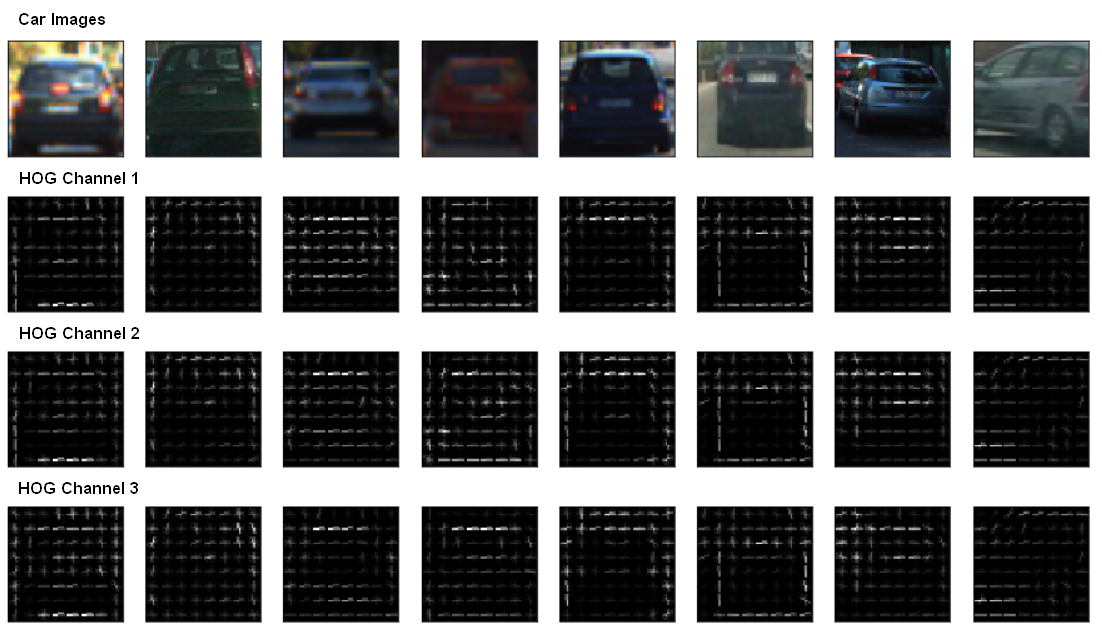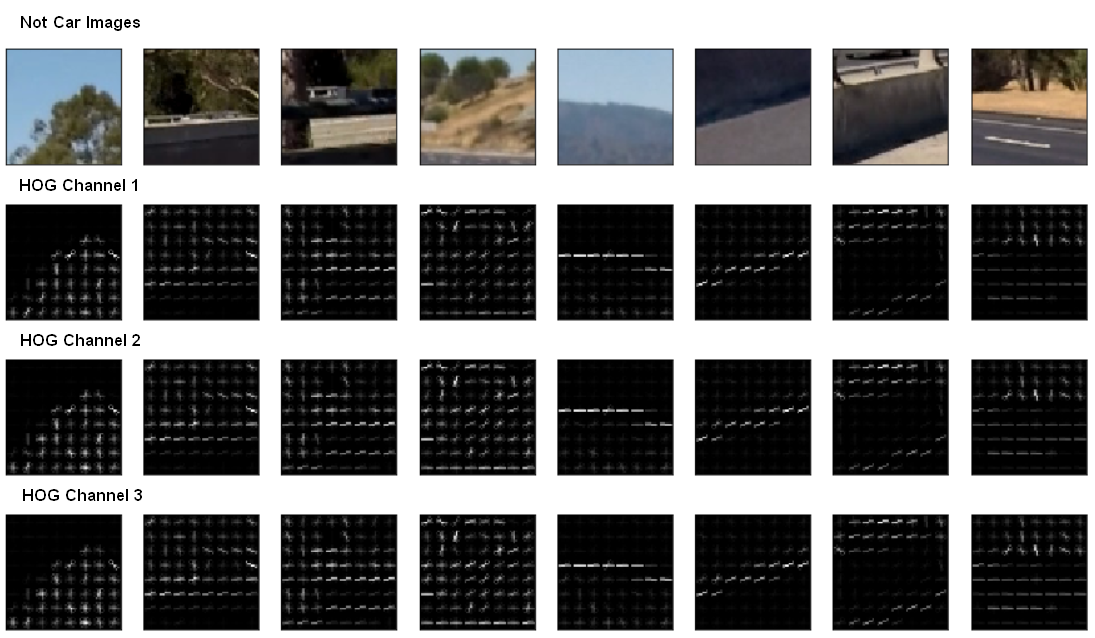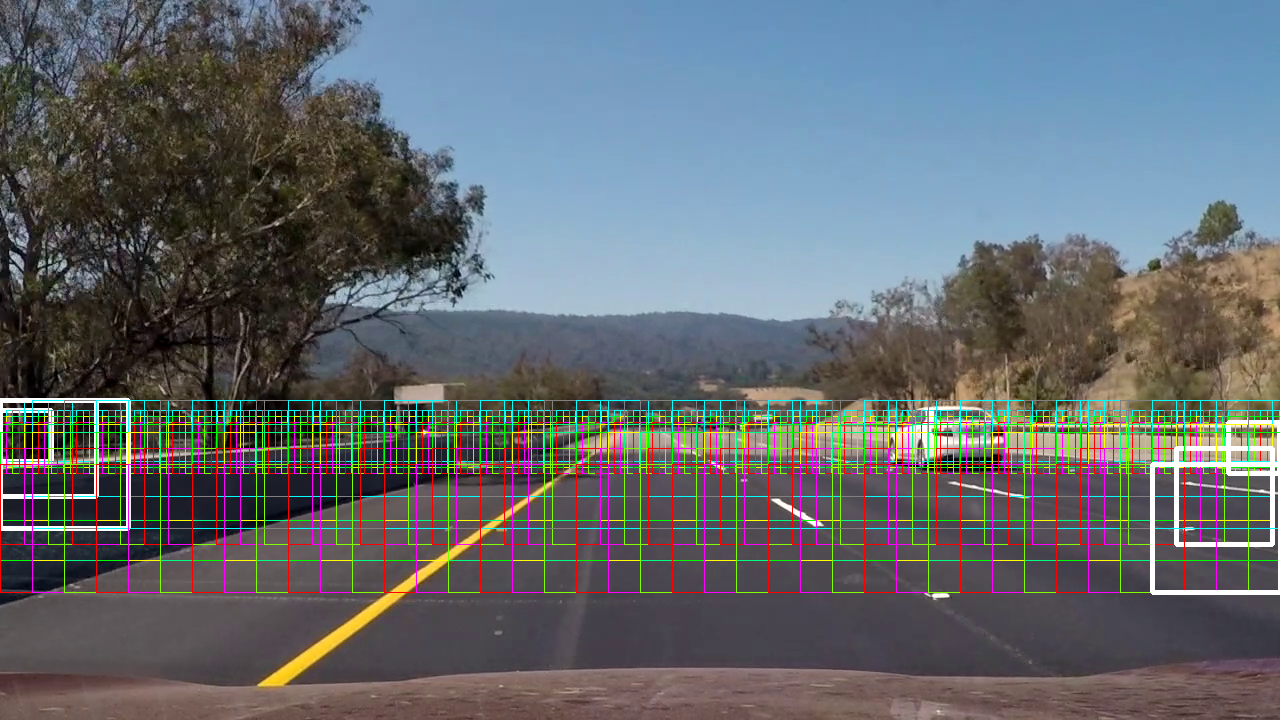The goals / steps of this project are the following:
- Perform a Histogram of Oriented Gradients (HOG) feature extraction on a labeled training set of images and train a classifier Linear SVM classifier
- Optionally, you can also apply a color transform and append binned color features, as well as histograms of color, to your HOG feature vector.
- Note: for those first two steps don't forget to normalize your features and randomize a selection for training and testing.
- Implement a sliding-window technique and use your trained classifier to search for vehicles in images.
- Run your pipeline on a video stream (start with the test_video.mp4 and later implement on full project_video.mp4) and create a heat map of recurring detections frame by frame to reject outliers and follow detected vehicles.
- Estimate a bounding box for vehicles detected.
Here I will consider the Rubric Points individually and describe how I addressed each point in my implementation.
main.py is entry. No training data provided, you can download vehicle and non-vehicle, then unzip to the project folder.
| CarND-Vehicle-Detection Folder Files | Description |
|---|---|
| main.py | entry, configure video, read and write frame, GUI |
| extract.py | features extract |
| tracker.py | all filters and heatmap |
| train.py | training parameters and classifier |
| utils.py | some draw image and text functions |
| P5.py | P5 interface for combinating with P4 |
| README.md | summarizing the results |
| carnd-p5-env.yml | conda environment |
| video_output | all project and debug video output |
| writeup_res | writeup resource |
| modle.p | trained classifier mode |
I used project provided dataset as the training data at first, but after a variety of comparison and testing, I found the classifier is very sensitive to the yellow lane line. I noticed the data of non-vehicles/GTI folder are not captured from this video, I thought these data have much effect on the classifier of this project, so I only use the data of non-vehicles/Extras folder as the not car data. In fact, my guess is correct, the effect of classifier has been significantly improved. Although these data are unbalanced, the accuracy of the classifier is somewhat unreliable, but it is undeniable that I have obtained a more effective classifier for this project. Finally, I got a accuracy 99.71%. Next, I will detail my steps.
Training Dataset, 20% for testing:
| Cars | Not Cars | Shape |
|---|---|---|
| 8792 | 5068 | (64x64x3) |
I use YUV color space with all channels, 11 orientations, 8 pixel per cell and 2 cells per block at last.
File: extract.py
Input: original image
Output: hog features
def get_hog_features(self, img, vis=False, feature_vec=True):
# Call with two outputs if vis==True
if vis == True:
features, hog_image = hog(img, orientations=self.orient,
pixels_per_cell=(self.pix_per_cell, self.pix_per_cell),
cells_per_block=(self.cell_per_block, self.cell_per_block),
block_norm='L2-Hys',
transform_sqrt=True,
visualise=vis, feature_vector=feature_vec)
return features, hog_image
# Otherwise call with one output
else:
features = hog(img, orientations=self.orient,
pixels_per_cell=(self.pix_per_cell, self.pix_per_cell),
cells_per_block=(self.cell_per_block, self.cell_per_block),
block_norm='L2-Hys',
transform_sqrt=True,
visualise=vis, feature_vector=feature_vec)
return featuresI resize the image to (16, 16), and flatten to a 1-D vector simply at last.
File: extract.py
Input: original image, shape size
Output: spatial binning color features
def bin_spatial(self, img, size=(32, 32)):
features = cv2.resize(img, size).ravel()
return featuresI didn't use numpy.histogram here, because it's very slow compared with cv2.calcHist. This help me save about 1.3s at last.
File: extract.py
Input: original image
Output: color histogram features
def color_hist(self, img, nbins=32, bins_range=(0, 256)):
channel1_hist = cv2.calcHist([img], [0], None, [nbins], bins_range).ravel()
channel2_hist = cv2.calcHist([img], [1], None, [nbins], bins_range).ravel()
channel3_hist = cv2.calcHist([img], [2], None, [nbins], bins_range).ravel()
hist_features = np.concatenate((channel1_hist, channel2_hist, channel3_hist))
return hist_featuresI use the simplest LinearSVC() as classifier, because it's fast for testing. After a lot of testing, I think this classifier is good enough.
I use the following steps to find the best combination and parameter configuration
Step1: Explore spatial size. To avoid randomness, I chose two color space as a contrast. Win: (16, 16)
| spatial size | feature vector length | YUV accuracy |
YCrCb accuracy |
|---|---|---|---|
| (8, 8) | 192 | 0.9118 | 0.9168 |
| (16, 16) Win! | 768 | 0.9261 | 0.9394 |
| (32, 32) | 3072 | 0.9089 | 0.9229 |
Step2: Explore histogram bins. To avoid randomness, I also chose two color space as a contrast. Win: 32
| histogram bins | feature vector length | YUV accuracy |
YCrCb accuracy |
|---|---|---|---|
| 8 | 24 | 0.9494 | 0.9627 |
| 16 | 48 | 0.9745 | 0.9792 |
| 32 Win! | 96 | 0.9953 | 0.9953 |
Step3: Explore color space. I use both spatial(size=(16, 16)) and histogram(bins=32) features for testing. To avoid randomness, I test 3 sets every color space. Win: HSV
| histogram + spatial | RGB accuracy |
HLS accuracy |
HSV Win! accuracy |
YCrCb accuracy |
YUV accuracy |
LAB accuracy |
|---|---|---|---|---|---|---|
| 1 | 0.9928 | 0.9943 | 0.9975 | 0.9907 | 0.9903 | 0.9957 |
| 2 | 0.9892 | 0.9975 | 0.9957 | 0.9910 | 0.9889 | 0.9943 |
| 3 | 0.9907 | 0.9932 | 0.9961 | 0.9935 | 0.9889 | 0.9935 |
Step4: Explore HOG parameters. All channels, YCrCb color space. Win: (12, 8, 2)
Here I reserve the bold font parameter settings for further exploration because it is unclear how the result of the final combination with the other features will be.
| orient | pixels per cell | cells per block | feature vector length | YCrCb accuracy |
|---|---|---|---|---|
| 7 | 8 | 2 | 4416 | 0.9896 |
| 9 | 8 | 2 | 5292 | 0.9867 |
| 10 | 8 | 2 | 5880 | 0.9928 |
| 11 | 8 | 2 | 6468 | 0.9925 |
| 12 | 8 | 2 | 7056 | 0.9961 |
| 13 | 8 | 2 | 7644 | 0.9921 |
| 7 | 8 | 4 | 8400 | 0.9907 |
| 8 | 8 | 4 | 9600 | 0.9921 |
| 9 | 8 | 4 | 10800 | 0.9943 |
| 10 | 8 | 4 | 12000 | 0.9914 |
| 10 | 16 | 2 | 1080 | 0.9953 |
| 11 | 16 | 2 | 1188 | 0.9943 |
Step5: Explore HOG Color space. orient=12, pixels_per_cell=8, cells_per_block=2, all channels. To avoid randomness, I test 3 sets every color space. Color space YCrCb wins.
Win: YCrCb
| HOG | RGB accuracy |
YCrCb accuracy |
YUV accuracy |
HSV accuracy |
HLS accuracy |
|---|---|---|---|---|---|
| 1 | 0.9548/7.10/59.79 | 0.9957/1.37/55.17 | 0.9918/1.56/55.35 | 0.9864/2.16/56.64 | 0.9853/2.35/59.43 |
| 2 | give up | 0.9946/1.33/56.36 | 0.9925/1.57/54.60 | 0.9878/2.38/56.97 | 0.9849/2.22/57.75 |
| 3 | give up | 0.9918/1.32/54.78 | 0.9935/1.54/55.65 | 0.9892/2.28/55.84 | 0.9864/2.32/56.09 |
Note: Accuracy format: accuracy/svc time/feature extract + svc time.
Step6: Explore combination.
| HOG | Histogram | Spatial | Accuracy |
|---|---|---|---|
| True (YCrCb) | True (HSV) | False | 0.9993 |
| True (YCrCb) | True (HSV) | True(HSV) | 0.9989 |
Get a very high accuracy, but the actual test results are not good, black car often do not recognize, I think there must be a problem, so no longer pay special attention to higher accuracy, but the actual validation results. So I tried several color combinations and HOG parameters, different channel. YUV color space finally looks good. And I slightly reduced the HOG parameters because it was too slow.
Final parameters configuration:
| color space | HOG parameters |
histogram bins |
spatial size |
feature vector length |
Accuracy |
|---|---|---|---|---|---|
| HOG: YUV/All channels Histogram: HSV/All channels Spatial: HSV/All channels |
orient: 11 pixels per cell: 8 cells per block: 2 |
32 | (16, 16) | 7332 | Accuracy: 0.9971 Train Time: 21.69s Total Time: 196.45s |
Here is all my output. You can trace the white arrows to get the pipeline.
| Window | ystart | ystop | scale | cells_per_step |
|---|---|---|---|---|
| 1 | 410 | 480 | 0.8 | 1 |
| 2 | 400 | 550 | 1.5 | 2 |
| 3 | 400 | 620 | 2 | 2 |
In the function below, I use the sliding window to get the Layer1 Input Boxes. Here I only calculated the HOG once. At the same time I also use the decision_function function, when the result is very positive, the box is added several times to make the window more smooth.
def find_cars(self, img, ystart, ystop, scale, step):
ctrans_tosearch = self.get_feature_image(img, self.c_color_space, ystart, ystop)
if self.h_color_space == self.c_color_space:
htrans_tosearch = ctrans_tosearch
else:
htrans_tosearch = self.get_feature_image(img, self.h_color_space, ystart, ystop)
if scale != 1:
imshape = ctrans_tosearch.shape
ctrans_tosearch = cv2.resize(ctrans_tosearch, (np.int(imshape[1] / scale), np.int(imshape[0] / scale)))
if self.h_color_space == self.c_color_space:
htrans_tosearch = ctrans_tosearch
else:
htrans_tosearch = cv2.resize(htrans_tosearch, (np.int(imshape[1] / scale), np.int(imshape[0] / scale)))
# Define blocks and steps as above
nxblocks = (ctrans_tosearch.shape[1] // self.pix_per_cell) - self.cell_per_block + 1
nyblocks = (ctrans_tosearch.shape[0] // self.pix_per_cell) - self.cell_per_block + 1
# 64 was the orginal sampling rate, with 8 cells and 8 pix per cell
window = 64
nblocks_per_window = (window // self.pix_per_cell) - self.cell_per_block + 1
cells_per_step = step # parameters['cells_per_step'] # Instead of overlap, define how many cells to step
nxsteps = (nxblocks - nblocks_per_window) // cells_per_step + 1
nysteps = (nyblocks - nblocks_per_window) // cells_per_step + 1
hog_features = self.extract_hog_features(htrans_tosearch)
bbox_list = []
slide_boxes = []
for xb in range(nxsteps):
for yb in range(nysteps):
ypos = yb * cells_per_step
xpos = xb * cells_per_step
xleft = xpos * self.pix_per_cell
ytop = ypos * self.pix_per_cell
# Extract the image patch
subimg = cv2.resize(ctrans_tosearch[ytop:ytop + window, xleft:xleft + window], (64, 64))
img_features = []
# Get color features
if self.spatial_feat:
spatial_features = self.bin_spatial(subimg, size=self.spatial_size)
img_features.append(spatial_features)
if self.hist_feat:
hist_features = self.color_hist(subimg, nbins=self.hist_bins)
img_features.append(hist_features)
if self.hog_feat:
hog_xstart = xpos
hog_xstop = xpos + nblocks_per_window
hog_ystart = ypos
hog_ystop = ypos + nblocks_per_window
hog = self.hog_reval(hog_features, hog_ystart, hog_ystop, hog_xstart, hog_xstop)
img_features.append(hog)
img_features = np.concatenate(img_features).reshape(1, -1)
# Scale features and make a prediction
test_features = self.X_scaler.transform(img_features)
test_prediction = self.svc.predict(test_features)
test_confidence = self.svc.decision_function(test_features)
xbox_left = np.int(xleft * scale)
ytop_draw = np.int(ytop * scale)
win_draw = np.int(window * scale)
box = ((xbox_left, ytop_draw + ystart), (xbox_left + win_draw, ytop_draw + win_draw + ystart))
slide_boxes.append(box)
if test_prediction == 1 and test_confidence > 0.2:
bbox_list.append(box)
if test_confidence > 0.8:
bbox_list.append(box)
if test_confidence > 1.2:
bbox_list.append(box)
if test_confidence > 1.4:
bbox_list.append(box)
return np.array(bbox_list), np.array(slide_boxes)There are all in file tracker.py. I use three layers filters to tracker real vehicle and filter false position.
def filter(self, box_lists):
# Layer 1
self.layer1_input_boxes = box_lists
self.layer1_output_boxes = self.detector.get_labeled_boxes(self.layer1_input_boxes, self.layer1_threshold, None)
self.layer1_heatmap = self.detector.heatmap
self.layer1_max_heat = self.detector.max_heat
# Layer 2
if self.layer1_output_boxes != []:
self.boxes.append(self.layer1_output_boxes)
else:
self.boxes.append([[[0,0], [0,0]]])
boxes_len = len(self.boxes)
if boxes_len > 0:
self.layer2_input_boxes = np.concatenate(np.array(self.boxes))
else:
self.layer2_input_boxes = []
layer2_threshold = min(boxes_len, self.layer2_threshold)
print('layer2_threshold', layer2_threshold, boxes_len, self.layer2_max_heat)
structure = None#[[1,1,1],[1,1,1],[1,1,1]]
self.layer2_output_boxes = self.detector.get_labeled_boxes(self.layer2_input_boxes, layer2_threshold, structure)
self.layer2_max_heat = self.detector.max_heat
self.layer2_heatmap = self.detector.heatmap
self.layer2_output_boxes = self.area_filter(self.layer2_output_boxes)
# Layer 3
self.update_box(self.layer2_output_boxes, self.layer1_output_boxes)Layer1 just gets the box from the original sliding window and uses heatmap to get the noisy object.
Input: boxes from sliding window
Processing: use heatmap with threshold=1
Output: layer1_output_boxes
Layer2 used to filter Layer1 noise by last N frames, and made a simple constraint to get the correct object.
Input: layer1_output_boxes
Processing:
- store input boxes to a queue, this queue has boxes of last N frames
- apply heatmap with threshold=min(queue_len, 10)
- filter small area and narrow boxes
Output: layer2_output_boxes
Layer3 is a little tricky, I added a lot of constraints for various scenarios.
Input: layer1_output_boxes, layer2_output_boxes
Processing:
- Create Vehicle for every box from layer2_output_boxes if this box doesn't intersect with others.
- Increase the Vehicle Confidence when find the vehicle from layer2 output
- Decrease Confidence if the Confidence large than 0, and cannot get valid boxes from layer2.
- If Confidence decrease N times in a row and still larger than 0, get boxes from layer1_output_boxes.
- All of this have a lot of validations, I mainly checked the overlap.
- Overlap ratio is the first considered.
- Cross rate as second.
- Size Scale
Output: Final boxes
Here is how to check the overlap.
| CarA | CarB | NewBox |
|---|---|---|
| CarA: ((1, 1), (4, 4)) | CarB: ((6, 3), (18, 11)) | NewBox: ((0, 0), (16, 8)) |
| Area_CarA: 3 * 3 = 9 | Area_CarB: 8 * 12 = 96 | Area_NewBox: 8 * 16 = 128 |
| Overlap_ratio_A: 9 | Overlap_ratio_B: 50 | |
| Cross_rate_A: 9/9 = 1 | Cross_rate_B: 50/96 = 0.52 | |
| Size_scale_A: 128 / 9 = 14.2 | Size_scale_B: 128 / 96 = 1.3 |
Considering overlap ratio as first. CarB wins this new box.
def cal_overlap_ratio(self, vehicle_box, detected_box):
Rectangle = namedtuple('Rectangle', 'xmin ymin xmax ymax')
v_b = Rectangle(vehicle_box[0][0], vehicle_box[0][1], vehicle_box[1][0], vehicle_box[1][1])
d_b = Rectangle(detected_box[0][0], detected_box[0][1], detected_box[1][0], detected_box[1][1])
dx = min(v_b.xmax, d_b.xmax) - max(v_b.xmin, d_b.xmin)
dy = min(v_b.ymax, d_b.ymax) - max(v_b.ymin, d_b.ymin)
v_b_area = (v_b.xmax - v_b.xmin) * (v_b.ymax - v_b.ymin)
d_b_area = (d_b.xmax - d_b.xmin) * (d_b.ymax - d_b.ymin)
min_area = min(v_b_area, d_b_area)
if (dx >= 0) and (dy >= 0):
area = dx*dy
overlap_ratio = area#(area / v_b_area + area / d_b_area) / 2
cross_rate = area / min_area
else:
overlap_ratio = 0
cross_rate = 0
size_scale = d_b_area / v_b_area
return overlap_ratio, size_scale, cross_rateHere's a link to my video result:
I use this code generater following video. Because I do not want to increase the review time, so I didn't show these code which from Project4.
Project With Lane Detection Debug
Project With Lane Detection Output
Here are two frames and their corresponding output:
In this project, I did a lot of parameter validation experiments, although some combinations get very high accuracy in training, but the actual result is not good. I've been trying to reduce the number of features to speed up processing, but fewer features often introduce too much noise or often do not recognize any object. So in the end I had to choose a lot of features. In addition, the choice of sliding window is also crucial. When identifying a black car, a large window is required because of a relatively large target when the car just appears. A small window is required when the car is away from the car, so different sliding windows are provided. But also because of this, the final window is relatively large changes, not particularly smooth, which is the need to further solve the problem. In short, this project still has a lot of room for improvement. Another question is how to accurately track a car, when it coincides with another, and then apart, whether the box still belongs to itself or needs to be further improved, I've got the correct result before, but that It's just by chance, not a subjective decision of my pipeline, so I'm going to take this video with the slightest mistake as the last submission.







